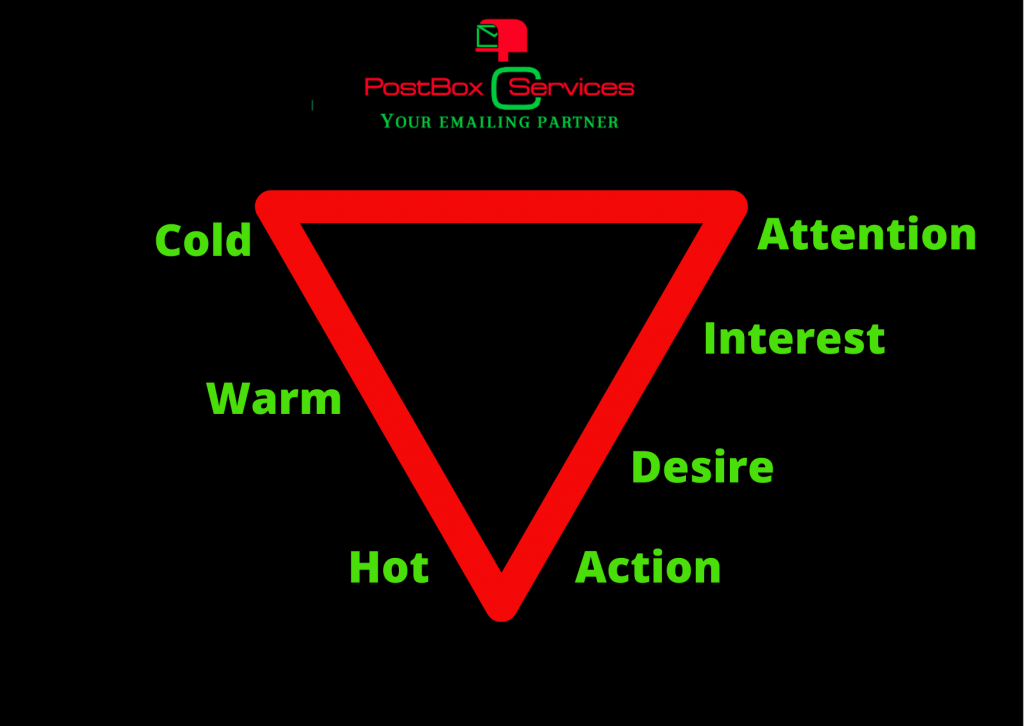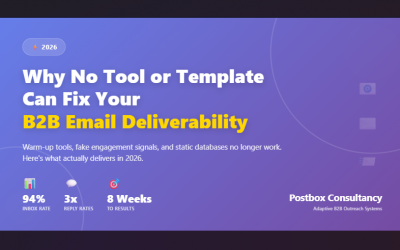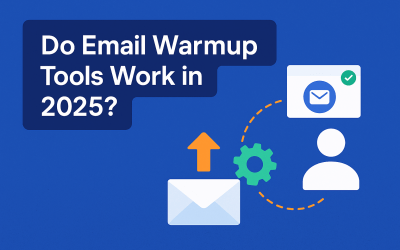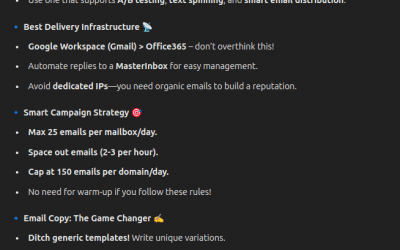PostBox Consultancy Services Cold Email Guide
Co Authors: Amalina Lavocah and Sandeep Saxena
Note: This is a living document and will be updated regularly with latest information and trends.
Version 1: September 10, 2021
Step by step cold email guide
Introduction
Every business needs to generate leads and convert them to paying customers. Companies spend lots of money on different marketing channels. Cold emailing is one of the most popular marketing channels for B2B lead generation.
We have developed this step by step cold email guide. Whether you are a beginner or an experienced cold email lead generation specialist it will help you equally.
What is a cold email?
Cold email is an email which you send to a business prospect who does not have any prior relationship with you and has not opted-in to receive the email in the first place.
What is the purpose of cold email?
Cold email is the first step in your email marketing funnel where you try to check the interest or generate interest in a business prospect. Through cold emails you try to warm up the cold prospects and turn them to warm or qualified leads.
The picture shown above will help you better understand how cold email fits in your email marketing funnel.
Now you must be thinking, “What’s the difference between cold email and marketing emails then?”.
Cold email vs. marketing email
Put it simply, cold emails are sent to prospects who do not know about a business but may be interested in the products/services which business offers. On the other hand marketing emails are emails sent to old/existing customers to engage them and make them aware about products/services/features.
Cold emailing is done by reaching out to brand-new prospects by:
- Sending targeted emails to people who have visited company’s website
- Compiling a list of specific people that you would reach out to (regardless of whether you compiled the list manually or obtained it through an agency)
Visually, the cold email uses a plain text style instead of marketing emails that contain brand colors, logos, images, and other brand-related content.
Marketing emails are sent to people who have opted in to hear from you by:
- Signing up for your newsletter on your website
- Signing up for a free trial on your product or service
- Your old and existing customers
Unlike cold emailing, marketing emails can be sent more often.
Now that we have established the definition of cold emailing and the differences between cold outreach and marketing emails, we will dive into the importance and challenges of cold emailing.
The importance of cold emailing
Although there are a thousand reasons why cold emailing is essential, I will be sharing the two most crucial ones:
Lead generation
True to its name, it does precisely that. The top of any sales funnel is generating leads, and once that is achieved, the second part is to get them to buy into your product or service.
Brand awareness
The more people you reach out to, the more brand awareness is created; thus, more people will be aware of your product or service.
Pre-targeting: If you plan to use cold emails to generate brand awareness – use pre-targeting ads on social media to generate some attention. It’s possible to use Google, Facebook, LinkedIn for these targeted ads to the business prospects in your cold list.
If your prospects already know you and can relate to your company’s name, logo and brand color your cold email outreach will give much better results.
PostBox Services Tip
What are the challenges of cold emailing?
Like the fear you get trying to sell yourself in an interview, cold emailing is not that different. In fact, it is more challenging than most communication. Imagine not having a relationship or no knowledge of the audience that you are writing to. It could go one of two ways – fly or flop. Pretty daunting, right?
The worst part for anyone sending cold emails? You guessed it, landing it in the spam folder.
But with any challenges come solutions. So in today’s blog, I will share PostBox Services’ cold emailing best practices with you. This includes different types of ways to send cold emails, a step-by-step guide, and how to avoid landing in the spam folder.
Is cold email considered spam?
The first question which comes to mind when someone plans to start cold emailing is “Is cold email considered spam?”
Cold emailing in itself is not referred to as spam. But not following the correct practices can categorize your cold emails as spam.
Let’s see what would be considered as spamming:
- Sending emails too often
- Continue to send emails even when someone has asked to be removed
- Not sending personalized emails but very generic content instead
- Not targeting business prospects but to everyone you get a hold of
- Not sending relevant, real and honest content (AKA fake news)
From a legal standpoint your cold emails need to comply with CAN-SPAM act to be not categorized as spam. This article from the Federal Trade Commission lists all of those requirements. And we will be covering later these points in cold email best practices.
https://www.ftc.gov/tips-advice/business-center/guidance/can-spam-act-compliance-guide-business
Another article from ZoomInfo which gives good background on this topic is here.
https://blog.zoominfo.com/is-cold-email-spam/
Steps and Best Practices for Cold Emails
Step 1: Create a cold email plan
Don’t be in a rush to shoot your first cold email. There is a lot of planning which needs to go before you start sending the emails. Spend some time to put a cold email plan which should cover below points:
- Goals: You need to identify your goals. It may be lead generation or brand awareness or market research.
- Budget: This is one of the most important things you need to look into because the rest of your plan needs to keep the budget in mind.
- Timelines: Set a timeline once you have identified your goals. If it’s a short-term project, for example you only need 50 attendees from your prospects for an upcoming webinar the timeline can be a few weeks. But if your goal is lead generation your timelines can be prolonged to months until you achieve or redefine your goal.
- Desired Results: Write down the desired results for every goal you identified in step 1. Make your result specific and time-bound. For example, instead of putting the result as “I need to generate more leads for my business in next six months”, put it as “I need to generate 50 warm leads every month using cold emails from the pharmaceutical companies with revenue ranging from 25 to 250 million dollars and based in North America”
- Prospect Identification: You should identify your prospects properly. There is no point in approaching someone working in a Fortune 100 company when your services are actually targeted at small and mid-sized businesses.
- Tools and technology: Spend some time to think about the tools you are going to use for prospecting, how you are going to find the correct email addresses of your prospects, what domain you will use, whether you need any tool for copywriting and personalization, which cold email tool to be used, etc. We have more detailed guidelines on tools further in this article.
- Human resources identification: Identify the resources in your team who are going to work on cold emails. You need to think about skills, time available with the resource (if the resource is shared), hiring, training required, etc
Step 2: Prospecting and list building
Now you have identified the prospects in your plan, it’s time to go ahead and start prospecting.
Prospecting is not about getting more and more email addresses but finding the correct details of best-qualified leads. And these details include first and last name, email address, designation, company name, industry, location, and anything else you think will be useful later on.
There can be a number of ways to get the details of the prospect.
You can get highly segmented and qualified prospect’s business contact information from companies like ZoomInfo.
If you plan to do it in-house you can use a tool like LinkedIn Sales Navigator.
There are numerous other tools that can help you with prospecting. Here is a small list of tools that can be useful in prospecting:
Step 3: Email verification or email list cleaning
Most of the prospecting tools give you verified email addresses or provide you a feature to separately clean your email lists. But in case your tool does not provide you with this feature or you want to cross verify the email list there are many tools that can help you.
Some of the tools which can be used for email list cleaning are:
Or simply go to AppSumo and search for a deal
If you are interested we have more technical details of email verification in an article here.
Step 4: Mailbox and email server
Now is the time to think about where you will host your mailboxes and which email server you will use to send cold emails.
There are many options available for mailbox hosting for example Google Workspace (former Gsuite), Office 365, Zoho, GoDaddy, etc. You can also approach us at Postbox Consultancy Services and we can host your mailboxes on our mailbox servers.
For sending emails you can use your mailbox above or you can use another email service like Sendgrid, Amazon SES, Mailgun. You can even build your own email server for this or can hire an expert to build an email server for you.
Gmass allows you to send unlimited cold emails and can route your emails via Sendgrid, Mailgun or SES if you meet their requirements. Check it out here.
We recommend using Google workspace (Gsuite) both for mailbox hosting and email sending.
Avoid using emails like info@, sales @, hello@, or any type of generic emails in cold emailing. These team mailboxes should not be used to send cold emails and they should also not be part of your cold email list.
Postbox Services Tip
Step 5: Warmup the domain
It is not a good idea to use your business domain for cold emailing. You should protect the reputation of your main business domain as much as possible and invest in building its reputation/authority with SEO and good email deliverability practices.
For cold email, it is better to have another look-alike domain. Once you have identified the domain, make sure you set the domain with proper DNS records (SPF, DKIM, DMARC) for email authentication. This is the most important step to get good email deliverability.
Remember not to use a domain for cold emailing immediately after the purchase. Best to warm up a new domain for at least a month before using it for cold emails.
There are many warm-up tools available in the market and some of them are listed here:
If you are a lead generation agency its better to maintain a pool of warmed-up domains.
Step 6: Copy writing and personalization
Out of all of the steps, this is the one where you should spend most of your time.
First few basics:
- Don’t send the same copy to everyone
- Make it personalized
- Decide on tone and voice to be used. Your tone should be acceptable to the segment
- Decide whether you want to “Hard Sell” or “Soft Sell” or use some other type of cold email. This article from Neil Patel has good details.
On the basis of the basics covered above, write your email copies. It’s best to get it proofread by an expert. Remember copywriting is not something that needs to be done one time but your copies need to be improved and evolved with time, experience, and A/B testing.
You can use or take help of ready made cold email templates available over internet and written by industry experts but don’t forget to customize them.. See these guidelines and cold email templates from Hubspot.
Remember your follow up emails need to be customized as well. See here how to write a follow-up email if you do not get a response.
There are several Artificial Intelligence (AI) tools available in the market that can help you hyper personalize cold emails using prospects online data for example
Step 7: Setup cold email tool/software
Now you have built the list, cleaned it, warmed up your domains, and have your copies written and proofread – you can go ahead and sign up for a cold email tool.
Cold email tools help you in building a cold email sequence and manage the whole cold email outreach program. Remember never to use a newsletter tool like Mailchimp for cold emails because they are really not meant for cold emailing.
Some of the most popular cold email tools are:
There are many more tools available in the market for cold emails and you can pick your favorite.
Once you have subscribed to your favorite email, configure your email server with the tool. Most of these tools provide a feature to integrate with Gsuite and other SMTP/IMAP servers.
Some of the tools do not allow you to integrate Gsuite and any other external SMTP and in that case you have to use the tool itself to send out the emails.
Step 8: Setup the sequence
Now is the final step where you set the sequence. Upload your list to the tool and create the sequences using your email copies. Go slow initially and check which copies/approach is giving better results. Don’t forget to use merge tags provided by these tools for personalization.
Step 9: Monitor the campaign and measure the key performance indicators (KPIs)
Look into the data to understand the results of your campaign. Here are some indicators that you can look into:
- Open rate: This shows if people are opening your emails. If the open rate is low, you could be landing in their spam box.
- Reply rate: Crucial if your goal is to get people to reply. CTA on your copy is to be clear and concise.
- Click rate: This will show just how interested your audience is in your service or product
- Bounce rate: Indicates your list quality. If you have really high bounce rate – pause the campaign for some time and think over why your bounce rates are high
Conclusion
There you have it, PostBox Services guide to cold emailing. We have covered the steps and best practices for cold emailing in this article that will help you run cold emails in long run. But if you have any questions/suggestions/feedback on this article please feel free to reach out to us.
Tags: Cold Email Agency, Mailshake Consultant, Gmass Consultant, Woodpecker Consultant, Lead Generation Consultant, Cold Email Consultant, Reply.io Consultant, Pardot Consultant,
Co Authors: Amalina Lavocah and Sandeep Saxena

Author: Amalina Lavocah
Based in the tropics of Southeast Asia, Amalina is a writer who loves adopting a topic-based authoring approach with the goal of crafting (un)structured content that’s concise, clear, and accessible to the end-user without sounding like a robot.
She lives and breathes words and the vast use of them for different story-telling approaches.
She also learned 68 creative ways to say ‘said’ in writing because who doesn’t love to spice things up?




